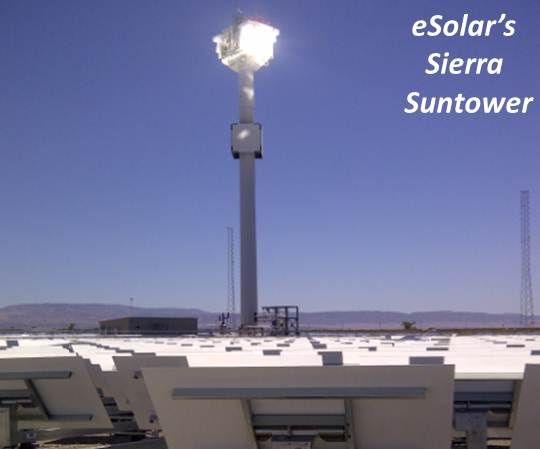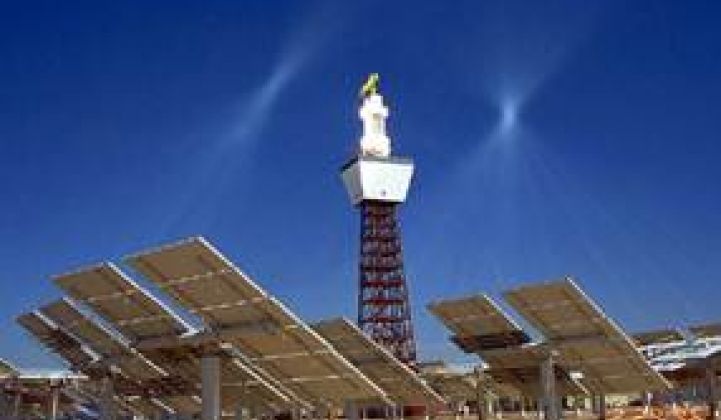“At what temperature might a songbird vaporize?” asked a recent Los Angeles Times piece about the BrightSource Energy Ivanpah solar power tower project. “Will the glare from five square miles of mirrors create a distraction for highway drivers? Can plumes of superheated air create enough turbulence to flip a small airplane? What happens if one of the Air Force's heat-seeking missiles confuses a solar power plant with a military training target?"
“The military, birders, aviation officials and others are eager for answers,” it added.
There may be good questions to ask about Ivanpah’s costs and funding. These are not those questions.
“Nothing of its type and size exists anywhere else in the world,” the article claimed.
That’s half right. Three small solar power tower projects are currently in service in Spain (2007, 2009 and 2011). Another, Solar One-Two, operated off and on from 1982 to 1999 near Barstow, California. BrightSource has two California projects in operation (2008 and 2011). And eSolar has operated one since 2009. SolarReserve and Abengoa projects are in development.
None of the consequences suggested by the Times has materialized.
It is true that the Google- and NRG-backed three-tower, 370-megawatt solar power plant under construction in Ivanpah, CA, near Las Vegas, will be the biggest such project in the world when it goes on-line in 2013.
The BrightSource power tower technology was developed by the designers of the trough technology that originated CSP at the nine Solar Energy Generating Stations (SEGS) still in operation today not far from Ivanpah. A central tower is situated amid a field of heliostats (flat mirrors) that concentrates the sun’s heat on its elevated receiver. High-pressure steam is heated to 1,000 degrees Fahrenheit, matching the tolerance of the best power plant turbine.

“BrightSource,” said Joe Long, plant manager for eSolar’s five-megawatt Sierra Suntower solar power plant in Lancaster, CA, “has monumental technology.”
The technology is sophisticated enough that multinational engineering giant Bechtel was brought on at Ivanpah for the engineering, procurement and construction (EPC). But it is not so sophisticated that it can’t be accurately vetted.
The LA Times piece suggested the California Energy Commission based its approval of Ivanpah largely on computer modeling. In fact, the project went through the same rigorous permitting any energy project faces from the CEC, the Bureau of Land Management, and experts from U.S. Fish and Wildlife, the FAA, the U.S. Department of Defense (DOD), the California Department of Fish and Game, CalTrans and the California Highway Patrol (CHP).
The Times piece quoted a scientist saying Ivanpah is “an experiment on a grand scale." But, as noted above, smaller such “experiments” have proven safe. Regarding avian harms, the article cited 30-year-old studies from Solar One-Two, but offered nothing current.
“We can’t substantiate any bird fatalities,” eSolar’s Long said of the three-and-a-half years of real-world experience with a very similar technology at Sierra Suntower. “We don’t have a bird kill issue.”
Long said he has personally seen birds fly into the aperture of the tower where steam, as at Ivanpah, is heated to 1,000 degrees Fahrenheit. “They fly out the other side.”
“While the insights from Solar One are valuable,” noted BrightSource Communications Director Keely Wachs, “it is unreasonable to assume its impacts would apply to newer, state-of-the-art technology that is specifically designed to avoid those risks.” And, Wachs added, the original study found such impacts to be “minimal.”
The Times article also quoted a Pentagon representative’s hypothesis that a heat-seeking missile might, during a training exercise, mistake the tower for a target. But the DOD signed off on the project after a long review process and Ivanpah is not located near a military training site. BrightSource is currently consulting with the DOD on proposed future sites.

Sierra Suntower is much closer than Ivanpah to the test pilot school at Edwards Air Force base mentioned in the Times article. “We have had no complaints from Edwards,” Long said. “There are days when you stand out here and it’s an airshow. We see U2s, B2s, B1s, just about every type of plane the U.S. military flies,” he added, “and we have never had any complaints at all.”
The Times article also raised concerns about small civilian aircraft being tossed by heat plumes, such as those from fossil plants. But “the large, high-velocity exhaust plumes from a gas or coal turbine engine simply do not exist at Ivanpah,” according to Wachs. Ivanpah “would emit only warm air at much lower velocity.”
The eSolar facility is three miles from Fox Field, where such planes come and go daily. “We actually have small planes and helicopters do orbits around the site because it’s something different,” Long said. There have been no incidents. “More than a thousand feet up,” Long said, “the dispersion is so great there is no concentrated energy up there.”
Though it raised the mirror glare concern, the Times article noted it “is one that experts say can be minimized if pilots and motorists use a dose of common sense and avoid staring.”
The CHP and other transportation experts called such risk “insignificant,” Wachs said. Ivanpah’s brightness “will be the equivalent of looking at a 100-watt light bulb from 25 feet away during daylight. LED billboards or LED headlights on newer automobiles are brighter and would be more distracting.”
Sierra Suntower, which is much closer to well-traveled highways than Ivanpah, has never had a complaint of a glare-caused accident, Long said.



